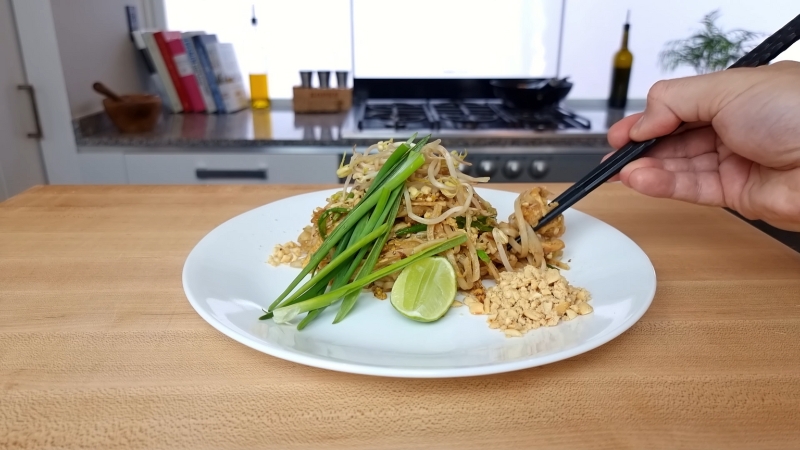When I first started cooking, Pad Thai was one of those dishes that seemed intimidating.
But once I learned how simple and versatile it is, it became a staple in my weeknight dinner rotation.
Here’s how I make a quick, flavorful Chicken Pad Thai packed with vibrant ingredients, easy to customize, and satisfying.
Let’s get straight into it.

Chicken Pad Thai
Pad Thai can seem intimidating at first, but once you learn how simple and customizable it is, it quickly becomes a weeknight favorite. This recipe delivers a quick, flavorful Chicken Pad Thai packed with vibrant ingredients and balanced flavors—sweet, salty, tangy, and a little spicy.
Equipment
- Large wok or skillet
- Mixing bowls
- Whisk or spoon (for sauce)
- Cutting board and knife
- Tongs or spatula
- Measuring cups and spoons
Ingredients
For the sauce
- 3 tbsp tamarind paste
- 3 tbsp fish sauce
- 2 tbsp soy sauce
- 3 tbsp brown sugar
- 1 tbsp rice vinegar
- 1/4 tsp chili flakes (optional)
For the stir-fry
- 8 oz rice noodles (flat, about 1/4 inch wide)
- 2 tbsp vegetable oil
- 2 large chicken breasts (or thighs), thinly sliced (about 1 lb)
- 3 cloves garlic, minced
- 2 eggs, beaten
- 1 cup bean sprouts
- 1/2 cup grated carrots
- 3 green onions, sliced
- 1/4 cup chopped roasted peanuts
- Fresh cilantro and lime wedges for garnish
Instructions
- Step 1: Prepare the NoodlesSoak the rice noodles in warm water for 20–30 minutes until they’re pliable but not mushy. Drain and set aside.(Shortcut: You can boil them for 3–5 minutes, but watch them closely!)
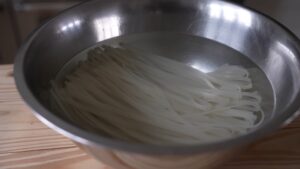
- Step 2: Make the SauceIn a small bowl, whisk together tamarind paste, fish sauce, soy sauce, brown sugar, rice vinegar, and chili flakes.Taste and adjust for balance—it should be tangy, salty, and slightly sweet.
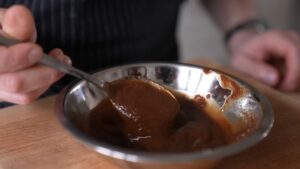
- Step 3: Cook the ChickenHeat 1 tbsp oil in a wok or large skillet over medium-high heat.Add the sliced chicken, season lightly with salt and pepper, and stir-fry for 3–4 minutes until cooked through.Remove from the pan and set aside.
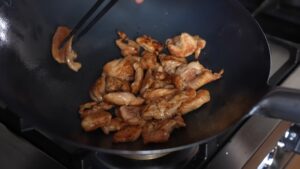
- Step 4: Stir-fry the AromaticsIn the same pan, add another tbsp of oil and the minced garlic. Stir-fry for about 30 seconds until fragrant.Push the garlic to the side and pour in the beaten eggs. Scramble gently, then mix them into the garlic.

- Step 5: Combine Everything and Add the VeggiesAdd the soaked noodles, cooked chicken, and prepared sauce to the pan.Toss everything quickly to coat the noodles evenly with the sauce.Stir in bean sprouts, grated carrots, and green onions. Stir-fry for another 1–2 minutes.The veggies should stay slightly crisp
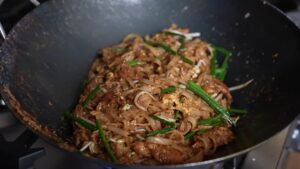
- Step 7: Garnish and ServeTransfer to plates and top with chopped peanuts, fresh cilantro, and a squeeze of lime.Serve hot with extra lime wedges on the side.
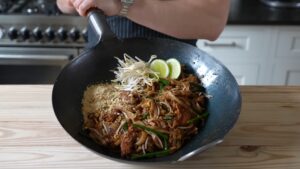
Video
Notes
Cooking Tips
- Tamarind Substitute: No tamarind? Mix 1 tbsp lime juice with 1 tbsp ketchup.
- Customizable Protein: Swap chicken for shrimp, tofu, or a combination of both.
- Extra Crunch: Toast the peanuts before adding them for more flavor.
- Spice It Up: Add more chili flakes or drizzle Sriracha on top.
- Make Ahead: The sauce can be stored in the fridge for up to a week.
Interesting Facts
- Tamarind is a tropical fruit used in Thai cuisine for its unique tangy flavor. It’s also rich in antioxidants and can help with digestion.
- Rice Noodles are naturally gluten-free, making this dish a great option for those with gluten sensitivities.
- Pad Thai was popularized in Thailand during the 1930s as part of a government campaign to promote national identity and reduce rice consumption.
